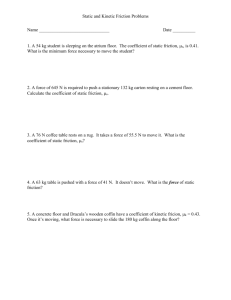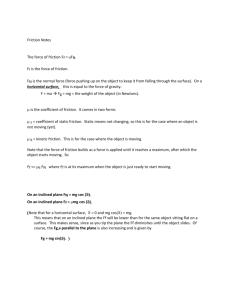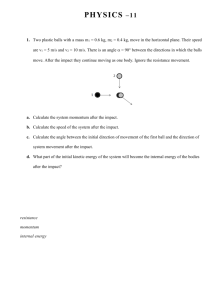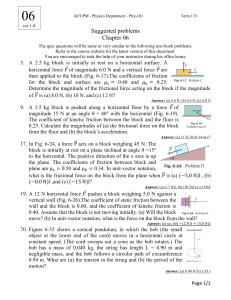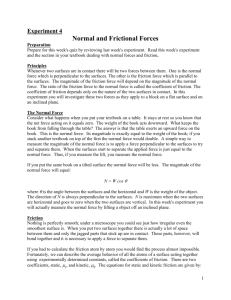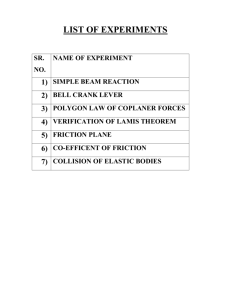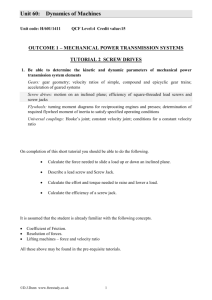Page 43, #75. A rocket rises vertically, from rest, with an acceleration
advertisement
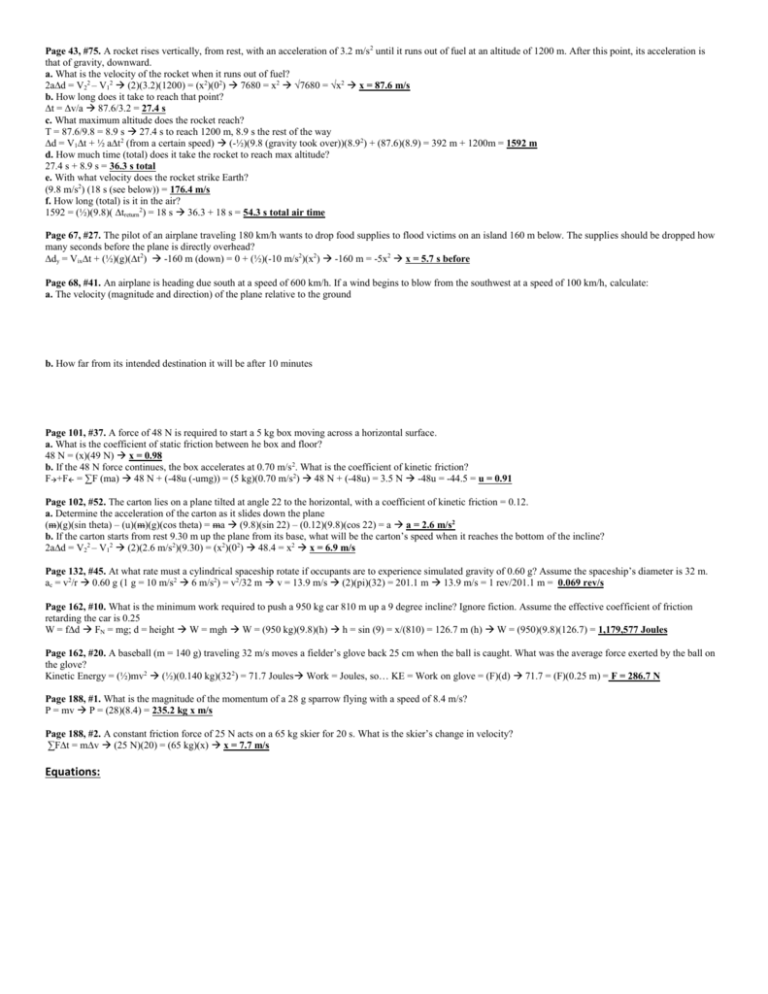
Page 43, #75. A rocket rises vertically, from rest, with an acceleration of 3.2 m/s2 until it runs out of fuel at an altitude of 1200 m. After this point, its acceleration is that of gravity, downward. a. What is the velocity of the rocket when it runs out of fuel? 2a∆d = V22 – V12 (2)(3.2)(1200) = (x2)(02) 7680 = x2 √7680 = √x2 x = 87.6 m/s b. How long does it take to reach that point? ∆t = ∆v/a 87.6/3.2 = 27.4 s c. What maximum altitude does the rocket reach? T = 87.6/9.8 = 8.9 s 27.4 s to reach 1200 m, 8.9 s the rest of the way ∆d = V1∆t + ½ a∆t2 (from a certain speed) (-½)(9.8 (gravity took over))(8.92) + (87.6)(8.9) = 392 m + 1200m = 1592 m d. How much time (total) does it take the rocket to reach max altitude? 27.4 s + 8.9 s = 36.3 s total e. With what velocity does the rocket strike Earth? (9.8 m/s2) (18 s (see below)) = 176.4 m/s f. How long (total) is it in the air? 1592 = (½)(9.8)( ∆treturn2) = 18 s 36.3 + 18 s = 54.3 s total air time Page 67, #27. The pilot of an airplane traveling 180 km/h wants to drop food supplies to flood victims on an island 160 m below. The supplies should be dropped how many seconds before the plane is directly overhead? ∆dy = Vix∆t + (½)(g)(∆t2) -160 m (down) = 0 + (½)(-10 m/s2)(x2) -160 m = -5x2 x = 5.7 s before Page 68, #41. An airplane is heading due south at a speed of 600 km/h. If a wind begins to blow from the southwest at a speed of 100 km/h, calculate: a. The velocity (magnitude and direction) of the plane relative to the ground b. How far from its intended destination it will be after 10 minutes Page 101, #37. A force of 48 N is required to start a 5 kg box moving across a horizontal surface. a. What is the coefficient of static friction between he box and floor? 48 N = (x)(49 N) x = 0.98 b. If the 48 N force continues, the box accelerates at 0.70 m/s2. What is the coefficient of kinetic friction? F+F = ∑F (ma) 48 N + (-48u (-umg)) = (5 kg)(0.70 m/s2) 48 N + (-48u) = 3.5 N -48u = -44.5 = u = 0.91 Page 102, #52. The carton lies on a plane tilted at angle 22 to the horizontal, with a coefficient of kinetic friction = 0.12. a. Determine the acceleration of the carton as it slides down the plane (m)(g)(sin theta) – (u)(m)(g)(cos theta) = ma (9.8)(sin 22) – (0.12)(9.8)(cos 22) = a a = 2.6 m/s2 b. If the carton starts from rest 9.30 m up the plane from its base, what will be the carton’s speed when it reaches the bottom of the incline? 2a∆d = V22 – V12 (2)(2.6 m/s2)(9.30) = (x2)(02) 48.4 = x2 x = 6.9 m/s Page 132, #45. At what rate must a cylindrical spaceship rotate if occupants are to experience simulated gravity of 0.60 g? Assume the spaceship’s diameter is 32 m. ac = v2/r 0.60 g (1 g = 10 m/s2 6 m/s2) = v2/32 m v = 13.9 m/s (2)(pi)(32) = 201.1 m 13.9 m/s = 1 rev/201.1 m = 0.069 rev/s Page 162, #10. What is the minimum work required to push a 950 kg car 810 m up a 9 degree incline? Ignore fiction. Assume the effective coefficient of friction retarding the car is 0.25 W = f∆d FN = mg; d = height W = mgh W = (950 kg)(9.8)(h) h = sin (9) = x/(810) = 126.7 m (h) W = (950)(9.8)(126.7) = 1,179,577 Joules Page 162, #20. A baseball (m = 140 g) traveling 32 m/s moves a fielder’s glove back 25 cm when the ball is caught. What was the average force exerted by the ball on the glove? Kinetic Energy = (½)mv2 (½)(0.140 kg)(322) = 71.7 Joules Work = Joules, so… KE = Work on glove = (F)(d) 71.7 = (F)(0.25 m) = F = 286.7 N Page 188, #1. What is the magnitude of the momentum of a 28 g sparrow flying with a speed of 8.4 m/s? P = mv P = (28)(8.4) = 235.2 kg x m/s Page 188, #2. A constant friction force of 25 N acts on a 65 kg skier for 20 s. What is the skier’s change in velocity? ∑F∆t = m∆v (25 N)(20) = (65 kg)(x) x = 7.7 m/s Equations:
